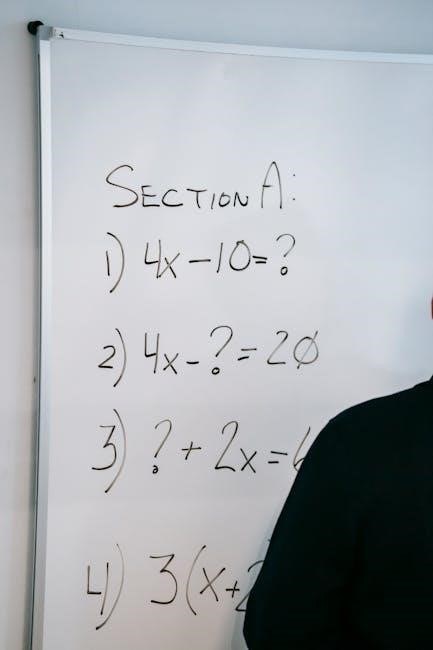Overview of the Curriculum
The Math Expressions Grade 6 curriculum is designed to provide a comprehensive understanding of mathematical concepts, fostering problem-solving skills and critical thinking. It aligns with educational standards, ensuring students master essential skills in areas such as operations with multi-digit numbers, algebraic thinking, and geometry. The curriculum builds on previous knowledge while introducing more complex ideas, preparing students for higher-level math. Homework plays a pivotal role in reinforcing classroom lessons, allowing students to practice and apply what they’ve learned. The Remembering Answer Key PDF serves as a valuable resource, offering detailed solutions and explanations to homework problems. This tool not only helps students verify their answers but also provides insights into common mistakes, enabling them to improve their understanding. By integrating word problems and real-world applications, the curriculum encourages students to connect math to everyday life, making learning more engaging and relevant.
Importance of Homework in Math Education
Homework is a cornerstone of math education, serving as a bridge between classroom instruction and independent learning; It reinforces concepts taught in school, allowing students to practice and master skills at their own pace. Regular homework helps build consistency, ensuring that math becomes a familiar and manageable tool for problem-solving. By completing assignments, students develop critical thinking and analytical skills, essential for tackling complex mathematical challenges. Homework also fosters accountability and time management, as students learn to prioritize tasks and meet deadlines. Furthermore, it provides an opportunity for students to identify areas where they need additional support, enabling them to address gaps in understanding before they widen. The Remembering Answer Key PDF complements homework by offering a reference for self-correction, helping students learn from mistakes and gain confidence in their abilities. Ultimately, homework cultivates a growth mindset, equipping students with the resilience and determination needed to excel in math and beyond.
Structure of the Answer Key PDF
The Remembering Answer Key PDF for Math Expressions Grade 6 is designed to provide clear and concise solutions to homework problems. Organized by chapters or modules, it aligns with the curriculum, ensuring easy navigation. Each section contains numbered problems corresponding to the textbook, with answers presented in a straightforward format. For complex questions, detailed step-by-step solutions are included to guide students through the problem-solving process. The PDF also highlights common mistakes and offers tips to avoid them, fostering a deeper understanding of math concepts. Additional resources, such as quick reference guides for formulas and definitions, are often included to support learning. This structured approach allows students and teachers to review homework efficiently, making it an invaluable tool for reinforcing math skills and preparing for assessments.
Understanding Math Expressions
Math expressions involve numbers, operations, and variables, representing mathematical relationships. They can be simple or complex, using symbols like +, -, ×, ÷, and exponents. Visualization tools, such as bar models and number lines, help students grasp abstract concepts. Common challenges include interpreting multi-step problems and applying expressions to real-world scenarios.
Definition and Components
A math expression is a combination of numbers, operations, and variables that represent a mathematical relationship. It can be simple, like 5 + 3, or complex, involving multiple operations and symbols. Key components include numbers (e.g., 12, 45), operations (+, -, ×, ÷), and variables (e.g., x, y). Expressions may also contain exponents, parentheses, and constants. For example, 3x + 4 combines a variable, a coefficient, and a constant. Understanding these components is crucial for solving problems and simplifying expressions; Students often use visualization tools, like bar models or number lines, to break down expressions into manageable parts. Recognizing patterns and relationships within expressions helps build foundational math skills. Practicing with expressions prepares students for advanced concepts like algebra and problem-solving. Regular homework and the use of resources like answer keys reinforce these skills, ensuring mastery of math expressions in Grade 6.
Visualization of Math Concepts
Visualization is a powerful tool for understanding math concepts, especially in Grade 6. By converting abstract ideas into visual representations, students can better grasp relationships between numbers and operations. Tools like bar models, number lines, and algebra tiles help break down complex problems into manageable parts. For example, bar models can illustrate multi-step word problems, while number lines show the distance between numbers, aiding in operations like addition and subtraction. These visual methods also help identify patterns and connections, making math more intuitive. Homework often includes activities that encourage students to draw or create models of math problems. The Remembering Answer Key PDF provides examples of how to visualize concepts, reinforcing learning. By practicing visualization, students develop a deeper understanding of math expressions, preparing them for more advanced topics like algebra and geometry. This approach fosters problem-solving skills and builds confidence in tackling challenging math problems.
Common Challenges Faced by Students
Students in Grade 6 often face challenges when handling complex math expressions, particularly with multi-digit operations and algebraic thinking. Many struggle with understanding how to apply operations to large numbers and interpreting word problems. The transition from concrete to abstract concepts can be difficult, leading to confusion and errors. Additionally, some students rely heavily on calculators, which hinders their ability to develop mental math skills and problem-solving strategies. Time management during homework and tests is another issue, as intricate problems require careful thought. The pressure to perform well on standardized tests adds anxiety, further complicating their ability to focus. These challenges highlight the need for structured practice and visualization tools to enhance understanding and build confidence in math.

Solving Math Expressions Homework
Breaking down problems into manageable steps and using visual aids can simplify complex expressions. Practicing regularly and reviewing mistakes with the Remembering Answer Key enhances understanding and problem-solving skills effectively.
Effective Strategies for Problem Solving
Breaking problems into smaller, manageable steps is a proven strategy for tackling math expressions. Start by identifying key components and simplifying complex expressions. Using visual models or diagrams can help clarify relationships between numbers and operations. Practicing regularly and reviewing mistakes using tools like the Remembering Answer Key PDF enhances understanding and reduces errors. Applying real-world contexts to problems makes them more relatable and easier to solve. Encourage checking work by plugging numbers back into the original problem to verify solutions. Leveraging online resources, such as educational websites or apps, provides additional practice opportunities. Staying organized with a structured study schedule ensures consistent progress. By combining these approaches, students can build confidence and master math expressions effectively.
Real-World Applications of Math Expressions
Math expressions are fundamental tools for solving real-world problems, making them essential for everyday life. From budgeting and cooking to engineering and finance, these skills are invaluable. For instance, understanding how to simplify and evaluate expressions helps in calculating totals, discounts, or measurements. In cooking, doubling a recipe requires multiplying ingredients, a practical application of math expressions. Construction workers use expressions to calculate materials needed for a project, ensuring accuracy and efficiency. Even in personal finance, balancing a checkbook or calculating interest involves math expressions. These applications highlight the importance of mastering math concepts. Tools like the Remembering Answer Key PDF and online resources provide support for students to grasp these skills. By connecting math to real-life scenarios, students can appreciate its relevance and develop problem-solving abilities that extend beyond the classroom. This practical approach makes learning math expressions engaging and meaningful for grade 6 students.
Identifying and Correcting Common Mistakes
Identifying and correcting common mistakes in math expressions is crucial for building a strong foundation in mathematics. Students often struggle with order of operations, misplacing decimal points, or misaligning digits during multi-digit calculations. For instance, forgetting to follow the PEMDAS rule (Parentheses, Exponents, Multiplication and Division, Addition and Subtraction) can lead to incorrect answers. Additionally, errors in setting up equations for word problems are frequent, highlighting the need for careful reading and translation of words into mathematical symbols. The Remembering Answer Key PDF serves as an invaluable resource, providing step-by-step solutions that help students pinpoint where they went wrong. By comparing their work to the answer key, students can identify patterns in their mistakes and develop strategies to avoid them. Regular review and practice, combined with the use of digital tools like Google’s equation solver, can enhance accuracy and confidence in solving math expressions. This iterative process of error detection and correction is essential for mastering grade 6 math concepts.

Key Concepts in Grade 6 Math
Grade 6 math focuses on multi-digit operations, algebraic thinking, geometry, and word problems. Students learn to solve complex equations, understand spatial relationships, and apply mathematical reasoning to real-world scenarios.

Operations with Multi-Digit Numbers
Operations with multi-digit numbers are foundational in Grade 6 math, building on basic multiplication and addition skills. Students learn to perform calculations involving numbers with multiple places, such as hundreds, thousands, and beyond. Using place value understanding, they master standard algorithms for addition, subtraction, multiplication, and division. For example, multiplying multi-digit numbers involves breaking them into smaller parts and applying the distributive property. Real-world applications, like calculating total costs or measurements, make these skills practical. The curriculum also emphasizes mental math strategies and estimating to check reasonableness. Practice with multi-digit operations prepares students for algebra and higher-level math. Using tools like the Remembering Answer Key PDF, students can review homework and improve accuracy by following step-by-step solutions. This section highlights common challenges, such as regrouping in subtraction or managing zeroes in multiplication, and provides tips for overcoming them. Regular practice and understanding place value are key to mastery.
Grade 6 math introduces students to algebraic thinking, a foundational skill for solving equations and understanding relationships between numbers. This section focuses on identifying patterns, creating expressions, and solving one-step equations. Students learn to use variables to represent unknown values and apply operations to isolate them. For example, solving ( x + 3 = 7 ) involves understanding inverse operations to find ( x = 4 ). Visual models, such as balance scales, help students grasp the concept of equality and how operations affect both sides of an equation. Real-world applications, like calculating total costs or distances, make algebraic thinking practical. The curriculum also emphasizes writing and interpreting expressions, such as ( 2(5x) ), to represent real-life scenarios. Using tools like the Remembering Answer Key PDF, students can review homework and gain confidence in their problem-solving abilities. This section builds a strong foundation for more complex algebraic concepts in higher grades.

Understanding Geometry and Measurement
Math Expressions Grade 6 delves into geometry and measurement, essential skills for spatial awareness and practical problem-solving. Students learn to identify and classify shapes, such as triangles, rectangles, and polygons, based on their properties. They also explore perimeter, area, and volume, applying formulas to calculate these measurements. Converting units, like inches to feet or ounces to pounds, is emphasized to develop fluency in real-world applications. Visual tools, such as geometric models and number lines, help students visualize concepts like symmetry and scaling. The curriculum encourages solving problems involving time, money, and temperature, reinforcing the importance of measurement in daily life. Homework assignments often include drawing and labeling shapes, ensuring hands-on practice. The Remembering Answer Key PDF provides step-by-step solutions, aiding students in understanding and correcting their work. This section builds a solid foundation for advanced geometry and measurement skills in higher grades.
Approaches to Word Problems
Mastering word problems is a critical skill in Grade 6 math, requiring a combination of reading comprehension and mathematical reasoning. Students are taught to break down problems into manageable parts, identifying key numbers, operations, and relationships. The RIDE method—Read, Identify, Draw, and Execute—is often emphasized to guide students systematically. Visualizing the problem through diagrams or bar models helps clarify the underlying math concepts. Real-world contexts, such as calculating distances or budgeting money, make problems more relatable and engaging. The curriculum encourages checking solutions by reversing operations or substituting values, ensuring accuracy. Homework assignments frequently involve multi-step word problems, fostering critical thinking and application of learned strategies. The Remembering Answer Key PDF provides detailed solutions, enabling students to analyze their mistakes and refine their approaches. By practicing diverse problem types, students build confidence and proficiency in tackling complex scenarios, preparing them for higher-level math challenges.

Using the Remembering Answer Key
The Remembering Answer Key provides detailed solutions to homework problems, helping students verify their work and understand mistakes. It offers step-by-step explanations, promoting better grasp of concepts and improving problem-solving skills effectively.
How to Interpret the Answer Key
To effectively use the Remembering Answer Key for Math Expressions Grade 6, start by matching your homework problems with the corresponding solutions. The key provides step-by-step explanations, making it easier to identify where mistakes occurred. Pay attention to the structure of the solutions, as they often include visual models or algebraic methods to solve problems. For example, if you’re struggling with multi-digit operations, the key will break down each step, showing how to align numbers and perform calculations accurately. For algebraic expressions, the solutions may highlight how to simplify terms or solve equations systematically. Use the answer key to verify your answers and understand the reasoning behind each step. This will help you grasp concepts more deeply and improve your problem-solving skills. Additionally, the key often includes tips for common errors, so review these to avoid repeating mistakes in future assignments. By studying the answer key, you can transform your homework into a powerful learning tool. Regular review will enhance your understanding of math concepts and boost your confidence in tackling challenging problems. Over time, this practice will help you develop a stronger foundation in math and improve your overall performance in Grade 6.
Learning from mistakes is a crucial part of the learning process, and the Remembering Answer Key for Math Expressions Grade 6 is an invaluable tool for this purpose. When reviewing your homework, compare your answers with those in the key to identify errors. For each incorrect answer, carefully examine the step-by-step solution provided. Pay attention to where your approach differed from the correct method, whether it was a calculation error, a misunderstanding of the concept, or a misapplication of a formula. For example, if you struggled with simplifying algebraic expressions, the key will show how to combine like terms or apply the distributive property correctly. Use this feedback to understand your weaknesses and focus your study efforts on those areas. Additionally, the key often highlights common pitfalls, such as forgetting to carry over in multi-digit addition or misapplying the order of operations. By analyzing these patterns, you can develop strategies to avoid similar mistakes in the future. Regularly reviewing your errors with the answer key will help you build a stronger understanding of the material and improve your overall performance in math. Over time, this practice will enhance your problem-solving skills and boost your confidence in tackling challenging problems. The key not only corrects your work but also serves as a guide to mastering math concepts effectively. Reviewing homework effectively is essential for mastering math concepts in Grade 6. Start by creating a quiet and organized study environment to minimize distractions. Use the Remembering Answer Key PDF to check your answers, but avoid simply copying corrections. Instead, focus on understanding where you went wrong. For each incorrect answer, rework the problem on your own, using the key as a guide to identify gaps in your understanding. Highlight or underline key concepts or steps in the explanation to reinforce learning. Practice active recall by solving similar problems without looking at the key first. This helps solidify your knowledge and builds problem-solving confidence. If a concept remains unclear, use additional resources like textbooks or online tutorials to review it. Finally, keep a “mistakes journal” to track common errors and review them periodically. Regular reflection on your progress will help you stay motivated and improve your math skills over time. Consistency and thoroughness are key to achieving success in math. Consistency and organization are key to excelling in Math Expressions; Set a daily study schedule, break tasks into manageable parts, and use visual aids like graphs and charts to understand complex concepts better. Developing a structured study schedule is essential for mastering Math Expressions. Allocate specific time slots for each topic, ensuring a balance between practice and review. Start with easier problems to build confidence, then gradually move to more challenging ones. Incorporate regular breaks to maintain focus and prevent burnout. Use a planner or digital calendar to track progress and stay organized. Prioritize areas where you need improvement, referencing the Remembering Answer Key PDF for clarification on difficult concepts. Consistency is key; dedicate time daily to review and practice, even if it’s just for 20-30 minutes. This routine will help reinforce learning and ensure long-term retention of math skills. Digital tools offer engaging and effective ways to practice math concepts. Google’s search bar can instantly solve equations, providing step-by-step solutions for complex problems. Educational websites like Khan Academy and XtraMath offer interactive exercises tailored to grade-level skills, making practice fun and accessible. Math learning apps such as Photomath and Desmos provide visual explanations and real-time feedback, helping students understand difficult concepts. Utilize these tools to reinforce homework lessons and review challenging topics. For instance, solving equations on Khan Academy or practicing mental math with XtraMath can enhance fluency. Digital resources also allow for personalized learning, enabling students to focus on areas where they need improvement. Regular use of these tools can build confidence and improve problem-solving skills, ensuring math becomes an enjoyable and manageable subject. Effective communication with teachers is crucial for success in math education. Students should regularly ask questions to clarify doubts and seek feedback on their progress. Sharing concerns early helps teachers provide timely support. Maintaining open dialogue ensures that learning needs are met. Encourage students to discuss challenges they face, allowing teachers to tailor explanations and resources. Regular updates on homework completion and understanding help track progress. Active participation in class fosters engagement and builds a positive teacher-student relationship. Clear communication also helps identify strengths and areas for improvement, enabling personalized learning strategies. By fostering collaboration, students gain confidence in their abilities and develop essential problem-solving skills. Effective communication ensures a supportive learning environment, making math more accessible and enjoyable for everyone involved. Consistent interaction with teachers plays a key role in achieving academic success and understanding complex math concepts. Google offers quick math solutions by entering equations into the search bar. Educational websites like Khan Academy and tools like GeoGebra provide interactive learning. Math apps such as Photomath enhance problem-solving skills and understanding. For effective math learning, several websites stand out for their quality and engagement. Khan Academy offers free video tutorials and practice exercises, covering topics from basic arithmetic to advanced algebra. GeoGebra provides interactive math models, allowing students to visualize and explore concepts like geometry and algebra. IXL features personalized math practice with real-time feedback, tailored to grade-level curriculum. Mathway is a problem-solving tool that helps students solve math problems step-by-step, ideal for homework assistance. Additionally, CK-12 offers free digital textbooks and adaptive exercises, while Desmos provides a powerful graphing calculator for understanding complex equations. These platforms complement traditional learning, making math more accessible and engaging for grade 6 students. Several educational apps are designed to support grade 6 math learning, offering interactive and engaging experiences. Khan Academy Kids provides a free, fun platform with math games and activities tailored for young learners. Mathway is a problem-solving app that helps students work through equations step-by-step, ideal for homework assistance. GeoGebra offers interactive math models, enabling students to explore geometric shapes and algebraic concepts visually. Desmos features a powerful graphing calculator that simplifies understanding of complex equations. Additionally, Photomath uses a camera to scan math problems and provides detailed solutions, while XtraMath focuses on mastering basic arithmetic facts through timed drills. These apps cater to different learning styles, making math practice more enjoyable and effective for grade 6 students. Online communities and forums provide valuable support for grade 6 math students, offering platforms to discuss challenges and share solutions. Websites like Stack Exchange and Math Forums allow students to ask specific math questions and receive detailed explanations from experts. Reddit communities, such as r/learnmath and r/mathhelp, are popular for peer-to-peer support and interactive problem-solving. Additionally, platforms like Khan Academy and Chegg host forums where students can engage with teachers and peers, gaining insights into math expressions and homework strategies. These online spaces foster collaboration and provide access to a wealth of resources, helping students understand complex concepts and improve their math skills effectively. By leveraging these communities, students can address specific challenges and build confidence in their mathematical abilities.Learning from Mistakes Using the Answer Key
Best Practices for Reviewing Homework

Study Tips for Mastering Math Expressions
Creating a Study Schedule

Utilizing Digital Tools for Math Practice

Effective Communication with Teachers

Digital Resources for Math Learning
Recommended Educational Websites
Math Learning Apps for Grade 6
Online Communities and Forums